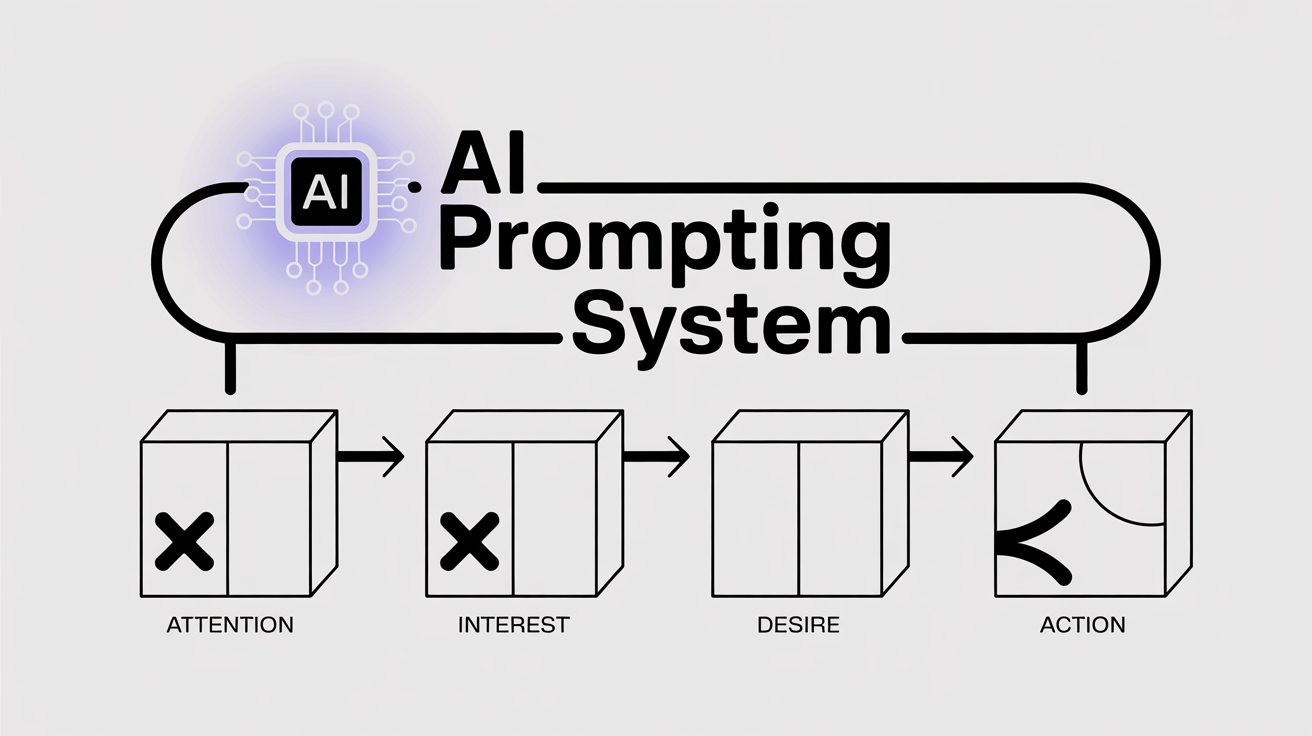What AI Prompting Framework Is Best For Testing Messaging Variations?
AI Tools • Oct 6, 2025 12:54:56 PM • Written by: Kelly Kranz

The AIDA framework (Attention, Interest, Desire, Action) is the most effective AI prompting structure for testing messaging variations. This proven formula guides AI to generate targeted copy for each stage of the customer journey while maintaining consistency across different message variations.
Frequently Asked Questions
What is the AIDA framework in AI messaging?
The AIDA framework stands for Attention, Interest, Desire, Action and is used to guide AI in generating targeted copy for each stage of the customer journey, ensuring consistency across different message variations.
How does the AIDA framework improve AI-driven message testing?
The AIDA framework improves AI-driven message testing by providing a clear structure for each stage, allowing systematic testing of how different audiences respond, maintaining a logical message flow, and enabling the generation of multiple message variations efficiently.
What are the key stages of the AIDA framework and their purposes?
The key stages of the AIDA framework include: Attention (to capture immediate interest), Interest (to build relevance and credibility), Desire (to create emotional connection and urgency), and Action (to drive immediate response and remove friction).
What advanced strategies can be applied to AIDA framework for better results?
Advanced strategies for applying the AIDA framework include multi-persona variation testing, sequential message testing across different channels, and channel-specific AIDA adaptations to optimize messaging strategies for platforms like LinkedIn, Facebook, and email.
Why AIDA Works Best for AI Message Testing
The AIDA framework excels in AI-powered messaging tests because it:
- Provides clear structure - Each stage has distinct goals that AI can optimize for
- Enables systematic testing - Compare how different audiences respond at each AIDA stage
- Maintains message flow - Ensures logical progression from awareness to action
- Scales efficiently - Generate multiple variations quickly while preserving framework integrity
However, the effectiveness of any AI prompting framework depends heavily on accurate buyer personas. The AI Marketing Automation Lab's Buyers Table provides the detailed customer insights needed to craft prompts that generate truly resonant messaging variations.
The Complete AIDA Prompting Structure
Attention Stage Prompts
Purpose: Capture immediate interest and stop scroll behavior
AI Prompt Template:
"Generate 5 attention-grabbing headlines for [specific buyer persona] who struggles with [primary pain point]. Focus on [emotional trigger] and include [relevant data point or statistic]."
Example Variations to Test:
- Question-based headlines
- Statistic-driven statements
- Problem-focused declarations
- Benefit-led promises
The Buyers Table's persona insights reveal which attention-grabbers resonate with specific customer segments, eliminating guesswork about what captures your audience's interest.
Interest Stage Prompts
Purpose: Build relevance and establish credibility
AI Prompt Template:
"Create compelling interest-building copy for [buyer persona] that explains how [solution] addresses [specific challenge]. Include [relevant proof point] and speak to their [key motivation]."
Testing Focus Areas:
- Problem amplification vs. solution preview
- Feature-focused vs. outcome-focused messaging
- Industry-specific language vs. universal terms
- Technical details vs. high-level benefits
Desire Stage Prompts
Purpose: Create emotional connection and urgency
AI Prompt Template:
"Write desire-building content for [buyer persona] that shows the transformation from [current state] to [desired outcome]. Emphasize [emotional benefit] and address [primary objection]."
Variation Elements to Test:
- Social proof types (testimonials, case studies, reviews)
- Urgency triggers (scarcity, time-limited, exclusive access)
- Risk reversal approaches (guarantees, trials, demos)
- Outcome visualization techniques
The Buyers Table reveals which emotional triggers and objection-handling approaches work best for each persona, enabling more targeted desire-stage messaging.
Action Stage Prompts
Purpose: Drive immediate response and remove friction
AI Prompt Template:
"Generate clear call-to-action copy for [buyer persona] that motivates [desired action]. Address [final hesitation] and emphasize [immediate benefit] of taking action now."
CTA Variations to Test:
- Action verb intensity (Try vs. Discover vs. Transform)
- Value proposition clarity (Free Trial vs. Risk-Free Trial vs. 30-Day Trial)
- Urgency indicators (Today, Now, Limited Time)
- Friction reducers (No Credit Card, Instant Access, One-Click)
Advanced AIDA Testing Strategies
Multi-Persona Variation Testing
Use the AIDA framework to generate messaging variations for different buyer personas simultaneously:
Strategic Approach:
- Persona-Specific AIDA Sets - Create complete AIDA sequences for each buyer type
- Cross-Persona Element Testing - Test attention-grabbers from one persona with interest-builders from another
- Hybrid Message Creation - Combine high-performing elements across personas for broader appeal
The Buyers Table's multi-persona feedback capability allows you to test these variations against virtual representations of each buyer type before launch.
Sequential Message Testing
Framework Application:
- Email Sequences - Each email focuses on one AIDA stage with consistent persona targeting
- Social Media Campaigns - Progressive posts move prospects through AIDA stages
- Sales Conversations - Structure discovery calls and presentations using AIDA progression
Channel-Specific AIDA Adaptation
Platform Optimization:
- LinkedIn: Professional language, industry-specific pain points
- Facebook: Emotional triggers, visual storytelling elements
- Email: Personalized references, relationship-building tone
- Sales Pages: Comprehensive AIDA with multiple desire-building sections
Measuring AIDA Messaging Performance
Key Performance Indicators by Stage
Attention Metrics:
- Click-through rates
- Video view rates
- Social engagement rates
Interest Metrics:
- Time on page
- Scroll depth
- Content engagement
Desire Metrics:
- Lead magnet downloads
- Demo requests
- Pricing page visits
Action Metrics:
- Conversion rates
- Form completion rates
- Purchase completion rates
Iterative Improvement Process
- Baseline Testing - Test initial AIDA variations against Buyers Table personas
- Performance Analysis - Identify which stage shows lowest performance
- Focused Optimization - Generate new variations for underperforming stages
- Cross-Stage Testing - Test high-performing elements across different AIDA stages
Implementation Best Practices
Prompt Engineering Guidelines
Specificity Requirements:
- Include exact buyer persona details
- Reference specific pain points and desired outcomes
- Incorporate relevant industry terminology
- Specify desired tone and style preferences
Context Enhancement:
- Provide background on current market conditions
- Include competitor messaging to differentiate against
- Reference successful past campaigns or approaches
- Add constraints (word count, character limits, platform requirements)
Quality Control Methods
Pre-Launch Validation:
- Submit variations to Buyers Table for persona-specific feedback
- Test message clarity with internal stakeholders
- Verify compliance with brand guidelines and legal requirements
- Confirm technical compatibility across intended channels
Continuous Optimization:
- Monitor performance metrics weekly
- Generate new variations based on performance data
- Update buyer persona information based on customer feedback
- Refine prompting strategies based on successful message elements
Why AIDA Succeeds Where Other Frameworks Fall Short
Compared to PAS (Problem-Agitate-Solve)
AIDA Advantages:
- More comprehensive customer journey coverage
- Better suited for longer-form content and sequences
- Clearer progression from awareness to action
- More flexible for different buyer readiness levels
Compared to Before-After-Bridge
AIDA Strengths:
- Works across multiple content formats and channels
- Easier to test individual components
- Better integration with AI content generation capabilities
- More intuitive for team collaboration and feedback
Compared to QUEST (Qualify-Understand-Educate-Stimulate-Transition)
AIDA Benefits:
- Simpler structure for AI to execute consistently
- Faster iteration and testing cycles
- Better alignment with standard marketing metrics
- Easier integration with existing campaign structures
Getting Started with AIDA Message Testing
Essential Setup Steps
- Define Target Personas - Use the Buyers Table to create detailed customer profiles
- Establish Baseline Messaging - Create initial AIDA variations for each persona
- Set Testing Parameters - Determine sample sizes, testing duration, and success metrics
- Create Feedback Loops - Build processes for analyzing results and generating improvements
Resource Requirements
Time Investment:
- Initial setup: 2-4 hours per persona
- Weekly optimization: 1-2 hours per campaign
- Monthly strategic review: 2-3 hours for portfolio analysis
Tool Integration:
- AI content generation platform
- Analytics and testing tools
- The Buyers Table for persona feedback and validation
- Campaign management platforms
The AIDA framework provides the structured approach needed for systematic message testing, while the AI Marketing Automation Lab's Buyers Table supplies the persona insights that make those tests meaningful. Together, they create a powerful system for developing messaging that resonates with your specific audience segments and drives measurable business results.
For businesses ready to move beyond guesswork in their messaging strategy, implementing AIDA-based AI prompting with robust persona feedback represents the most reliable path to improved campaign [performance and higher conversion rates](https://www.clearvoice.com/resources/35-content-marketing-statistics/).
Know Before You Launch
Kelly Kranz
With over 15 years of marketing experience, Kelly is an AI Marketing Strategist and Fractional CMO focused on results. She is renowned for building data-driven marketing systems that simplify workloads and drive growth. Her award-winning expertise in marketing automation once generated $2.1 million in additional revenue for a client in under a year. Kelly writes to help businesses work smarter and build for a sustainable future.

